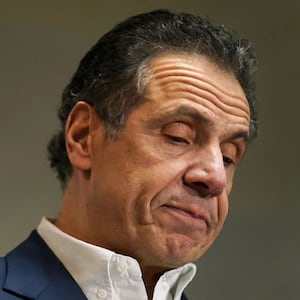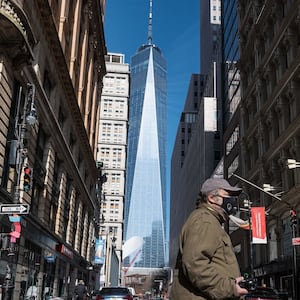For months the conventional wisdom among Democrats, amplified by their obliging claque in the media, was that lockdowns played an essential role in containing COVID-19. The great heroes, in addition to Anthony Fauci, were hardline governors like Michigan’s Gretchen Whitmer, California’s Gavin Newsom and, most of all, New York’s Andrew Cuomo.
Yet now, more than a year later, the lockdown states—starting with New York and New Jersey—are again leading the nation in coronavirus infections and deaths per capita.
By contrast, some of the states with Republican governors who were routinely castigated for unlocking things and supposedly killing their residents, most notably Florida, Georgia and Texas, did indeed suffer an increase in fatalities last summer. But since then, even after opening their economies, these states continue to suffer fatality rates per capita well below those of the locked-down Northeastern states and about equal to California, which has maintained one of the nation’s strictest lockdowns.
What emerge from these trends are some clear issues with transmission that transcend lockdowns, mask mandates and other punitive measures. However justified, such actions have not addressed the fundamental reasons why some geographies and populations have suffered so much more than others. That’s to say that while the blue state governors aren’t necessarily to blame for the surges their states are experiencing, it’s clear that the economically and personally disruptive measures did not have the expected impact.
What did make a big difference, it turns out, is not so much the severity of lockdowns but pre-existing conditions. The likely cause here can be best identified as “exposure density” brought on by crowded housing, transit, and office environments.
That helps explain why, after New York City’s suburbs were hit hard in the first wave, the current surge has hit the outer boroughs, where a much higher share of workers have had little choice but to continue taking the subway or other transit.
Nationwide, urban exposure to the pandemic also reflects their greater inequality. Higher rates of poverty and overcrowded housing accentuate the worst effects of the pandemic , which tore through impoverished parts of New York, Houston, Los Angeles County, Chicago’s poor south side, and similar areas. The Bronx, for example, has suffered an 80 percent worse death rate than denser yet wealthier Manhattan, while Brooklyn’s rate is 50 percent worse than Manhattan’s.
This can be seen also in the Los Angeles metropolitan area, whose sunshine-blessed and auto-dominated society suffered a fatality rate 60 percent below that of transit-oriented metro New York. Yet while fatality rates have been very low in affluent areas with fewer crowded households, such as west Los Angeles and Irvine, they have been much higher in areas like east and south Los Angeles. In Orange County, the fatality rate in affluent, single family dominated Irvine is 22 per 100,000 compared with 195 in neighboring Santa Ana, which is heavily Hispanic, poor and suffers crowded housing conditions.
This is an international phenomenon seen across the world’s great urban areas. During the first lockdown, almost 20 percent of the Parisian population fled to the countryside, accelerating an escapist trend that had been underway for years: the core city of Paris has lost 700,000 residents (nearly 25 percent of its population) since 1954, while millions of new inhabitants have swelled the suburban population. Meanwhile, the densely packed Department of Seine-Saint-Denis, a place synonymous there with inner ring suburban poverty, had a staggering 130 percent excess mortality rate when the virus first hit last year.
COVID-19, in effect, exposed in harsh terms the difficulties already faced by poorer residents of big cities, starting with morbidity issues related to heart attacks, diabetes and most especially obesity, a problem that is particularly acute in the United States.
So it turns out that the lockdowns haven’t been effective enough to squash infection or death rates, but have had harsh economic impacts and particularly in cities like Los Angeles, New York, New Orleans, San Francisco and Las Vegas that until last year had strong tourism economies. The lockdowns, whether justified or overwrought, also pummeled low-income workers. Roughly half of all job losses in April were in low-paying fields such as restaurants, hotels, and amusement parks. Almost 40 percent of Americans making under $40,000 a year have lost their jobs, seeing the wage gains made during the first three years of the Trump Administration evaporate.
Rather than playing out as a secular passion play, the pandemic should lead us to reconsider the vast inequality in our society and the advisability of pushing density, transit and apartment dwelling. Well-off people in Manhattan and San Francisco had options—like working from home or from an alternative location—that the poor do not enjoy. Some formerly diehard city residents are now putting bids on suburban houses further from the city.
In the post pandemic environment, no matter how intense the pressure from landlords and their media enablers, it is highly unlikely that places like Manhattan will recover most of the 500,000 full-time jobs that left after the initial lockdowns. Campaigns to force workers full-time back into offices have failed so far, and it’s unlikely that developments like Hudson Yards will ever really pay off. The voices like those at the Chicago Council of Global Trade insisting that things will soon go back to “normal” seems fanciful. In New York, the big city hit hardest by the pandemic, urban boosters recently met to look into how to make their city denser, even amidst population loss, a collapse of transit ridership and consistently poor growth rates.
Similarly, the much-ballyhooed drive for “transit-oriented development,” beloved by planners and some developers, and about to gain huge new investments from the Biden Administration, seems largely irrelevant by the emerging vision of “telecities.”
Even after “herd immunity” finally arrives, the impact of the pandemic is likely to remain. The desire to work at or near home, to avoid transit and look for more spacious housing will not end, except perhaps for younger, unmarried and childless people. A recent Harris poll found that upwards of two in five American city-dwellers are considering a move to less crowded places. The National Association of Realtors reports that households are “looking for larger homes, bigger yards, access to the outdoors and more separation from neighbors,” according to its surveys.
One recent report from Upwork finds that between 14 and 23 million Americans are seeking to move to a less expensive and less crowded place. This follows a national poll from the Los Angeles Times and Reality Check Insights taken just after the election in which more than half of all big city residents said their ideal setting for their next home was somewhere else.
Perhaps surprisingly, younger Americans led the way there. While 22 percent of big city Boomers said that they definitely would move elsewhere, more than a third of Gen Xers (36 percent) and Millennials (37 percent) said they would definitely leave if they were able. This lends credence to many other reports that have found that younger Americans are quite happy in areas outside big cities but may be anchored to them for career opportunities.
Big cities like New York can have a bright future, but first the lessons of COVID-19 have to be learned, and incorporated. Pointing madly at Florida or Texas as mindless miscreants, particularly if the current statistics hold, won’t solve the problems that big, blue cities need to confront, starting with the need to create enough affordable housing to reduce crowding.




